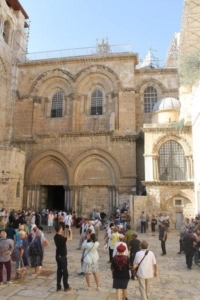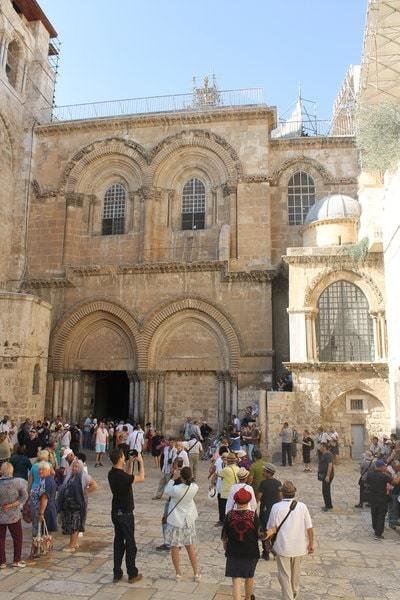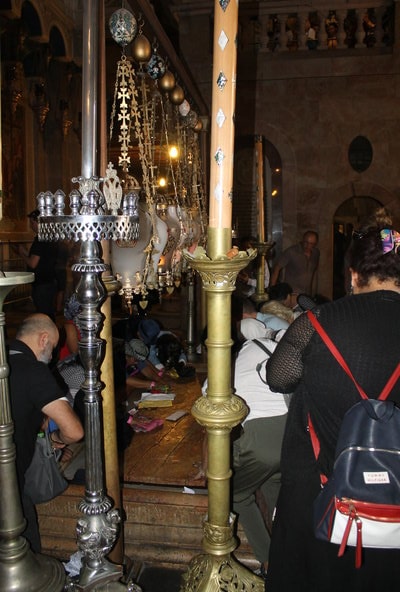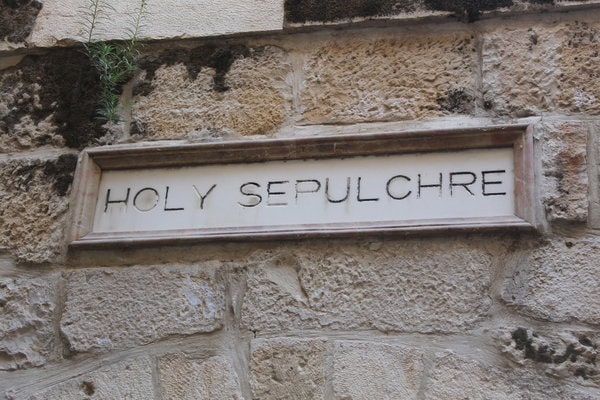Church of the Holy Sepulcher
 Also known as the Basilica of the Holy Sepulcher or Church of the Resurrection, the Church of the Holy Sepulcher is the epicenter of Christianity. According to Christian tradition, this place was acknowledged by Queen Helena, mother of Emperor Constantine, as the place of crucifixion, death and resurrection of Christ.
Also known as the Basilica of the Holy Sepulcher or Church of the Resurrection, the Church of the Holy Sepulcher is the epicenter of Christianity. According to Christian tradition, this place was acknowledged by Queen Helena, mother of Emperor Constantine, as the place of crucifixion, death and resurrection of Christ.
The Church of the Holy Sepulcher houses the tomb of Christ amid the magnificent Rotunda and the site of his crucifixion, the so-called Golgotha. For all these reasons, the Church of the Holy Sepulcher is a great pilgrimage site for Christians all over the world and a touristic site that gathers visitors of all faiths.
the Church of the Holy Sepulcher : A highly symbolic place
Despite its modest aspect, the Church of the Holy Sepulcher is a quite unique place in the world. Following the Via Dolorosa amid the Christian district market in Jerusalem, the church may be identified by its two large domes, its bell tower and its two magnificent wooden doors.
Status Quo to ensure peace amid faiths
Inside the church, the sight is unique. Six different Christian denominations hold their respective cults: Roman Catholics, Copts, Greek Orthodox, Syriacs, Apostolic Armenians and Ethiopians.
For centuries, these 6 Christian communities have learned to live together and to respect the traditions of one another. However, in order to avoid conflicts and political problems, the first Muslim sultans during the capture of Jerusalem set up a Status quo system through which "peace" could reign in the Holy Sepulcher. Later, with the creation of the State of Israel, the status quo was maintained and conflict resolution was transferred to the Israeli government.
At the same time, the same two Muslim families have kept the church’s courtyard and the opening / closing of doors. Many see it as a true symbol of peace and fraternity among different religious denominations.
Visits to the Church of the Holy Sepulcher
Visits to this holy place are organized in 5 main areas: the Basilica, the Hall, the Golgotha, the Cross and the Tomb. You may admire, in the atrium, the Anointing Stone on which, according to tradition, Joseph of Arimathea and Nicodemus had washed and prepared the body of Jesus before his burial.
To the right of the stone, a staircase leads to Golgotha. The place where the cross of Jesus was placed is at the altar of Golgotha. Another staircase leads to the rotunda of Anastasis ("the Resurrection") inside which is the stone where Christ was placed.
17 centuries of history
In 325 begins the construction of the Church of the Holy Sepulcher then called "the Church of the Resurrection". Destroyed by a fire after the capture of the city by the Persians in 614, it is quickly rebuilt and its stolen treasures are returned. The building was refurbished and renovated by the Crusaders.
The church, however, was damaged several times due to consecutive invasions, fires and earthquakes. These earthquakes damaged the aedicula that covers the tomb of Christ. It was finally rebuilt as part of the renovation works of the tomb at the beginning of 2017.
Today, the Church of the Holy Sepulcher welcomes every year over one million world visitors.




